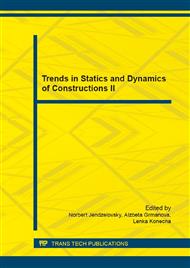[1]
J. Smutny, L. Pazdera, New techniques in analysis of dynamic parameters of rail fastening, InSight 46(10) (2004) 612-615.
DOI: 10.1784/insi.46.10.612.45212
Google Scholar
[2]
W.L. Lai, T. Kind, H. Wiggenhauser, Using ground penetrating radar and time-frequency analysis to characterize construction materials, NDT & E International 44(1) (2011) 111-120.
DOI: 10.1016/j.ndteint.2010.10.002
Google Scholar
[3]
P. Misak, B. Kucharczykova, T. Vymazal, P. Danek, P. Schmid, Determination of the quality of the surface layer of concrete using the tpt method and specification of the impact of humidity on the value of the air permeability coefficient, Ceramics-Silikaty 54(3) (2010).
Google Scholar
[4]
Y. Kawasaki, T. Wakuda, T. Kobarai, M. Ohtsu, Corrosion mechanisms in reinforced concrete by acoustic emission, Construction and Building Materials 48 (2013) 1240-1247.
DOI: 10.1016/j.conbuildmat.2013.02.020
Google Scholar
[5]
M. Korenska, M. Manychova, L. Pazdera, Experimental study of the nonlinear effects generated in a concrete structure with damaged integrity, Russian Journal of Nondestructive Testing 49(9) (2013) 530-537.
DOI: 10.1134/s1061830913090040
Google Scholar
[6]
J. Mata, A.T. de Castro, J.S. da Costa, Time–frequency analysis for concrete dam safety control: Correlation between the daily variation of structural response and air temperature, Engineering Structures 48 (2013) 658-665.
DOI: 10.1016/j.engstruct.2012.12.013
Google Scholar
[7]
L. Nohal, F. Hort, J. Dvoracek, P. Mazal, An experimental investigation of rolling contact fatigue of steels using acoustic emission method, Insight 55(12) (2013) 665-669.
DOI: 10.1784/insi.2012.55.12.665
Google Scholar
[8]
Y. Farnam, M.R. Geiker, D. Bentz, J. Weiss, Acoustic emission waveform characterization of crack origin and mode in fractured and ASR damaged concrete, Cement & Concrete Composites 60 (2015) 135-145.
DOI: 10.1016/j.cemconcomp.2015.04.008
Google Scholar
[9]
J. Smutny, Measurement and analysis of dynamic and acoustic parameters of rail fastening, NDT & E International - Independent Nondestructive Testing and Evaluation 37(2) (2004) 119-129.
DOI: 10.1016/j.ndteint.2003.08.003
Google Scholar
[10]
P. Mazal, J. Dvoracek, L. Pazdera, Application of acoustic emission method in contact damage identification, International Journal of Materials & Product Technology 41(1-4)SI (2011) 140-152.
DOI: 10.1504/ijmpt.2011.040292
Google Scholar
[11]
L. Topolar, L. Pazdera, V. Bilek, L. Dedeckova, Acoustic emission method applied on four point loading of concrete structures with and without small wires, in: Proceedings of the 50th Annual Conference on Experimental Stress Analysis, 2012, pp.477-484.
Google Scholar
[12]
P. Mazal, I. Dlouhy, P. Stolar, Fatigue properties of materials surface hardened by plasma nitriding and laser beam, Materials and Manufacturing Processes 12(1) (1997) 83-93.
DOI: 10.1080/10426919708935122
Google Scholar
[13]
L. Pazdera, L. Topolar, Application acoustic emission method during concrete frost resistance, Russian Journal of Nondestructive Testing 50(2) (2014) 127-131.
DOI: 10.1134/s1061830914020065
Google Scholar
[14]
R.B. Kogbara, S.R. Iyengar, Z.C. Grasley, E.A. Masad, D.G. Zollinger, Non-destructive evaluation of concrete mixtures for direct LNG containment, Materials & Design 82 (2015) 260-272.
DOI: 10.1016/j.matdes.2015.05.084
Google Scholar
[15]
L. Topolar, L. Pazdera, P. Cikrle, Acoustic emission monitoring during static modulus elasticity test of concrete specimen, Applied Mechanics and Materials 486 (2014) 267-272.
DOI: 10.4028/www.scientific.net/amm.486.267
Google Scholar
[16]
M. Korenska, L. Pazdera, L. Ritickova, Resonant inspection - Interesting non-destructive testing tools for determine quality of tested specimens, in: Proc. of the 6th International Conference of the Slovenian-Society-for-Non-Destructive-Testing, 2001, pp.45-48.
Google Scholar
[17]
B. Kucharczykova, P. Misak, T. Vymazal, Determination and evaluation of the air permeability coefficient using Torrent Permeability Tester, Russian Journal of Nondestructive Testing 46(3) (2010) 226-233.
DOI: 10.1134/s1061830910030113
Google Scholar
[18]
M. Korenska, L. Pazdera, M. Manychova, Acoustic emission method as a tool of partial discharges indication, International Journal of Materials & Product Technology 42(3-4) (2011) 209-218.
DOI: 10.1504/ijmpt.2011.045468
Google Scholar


